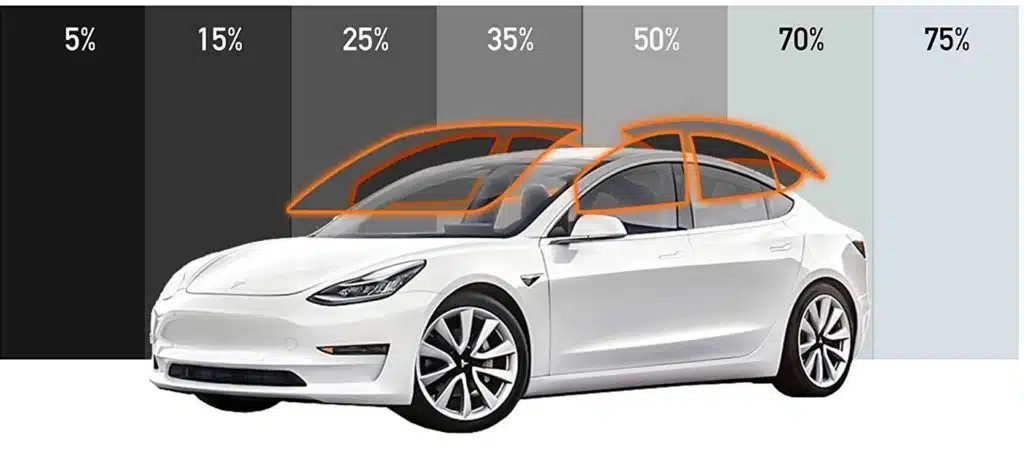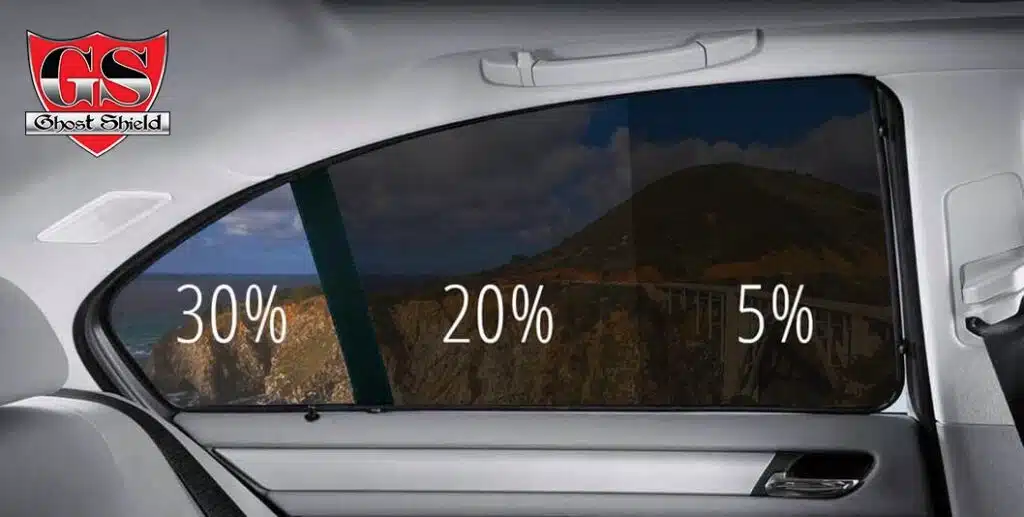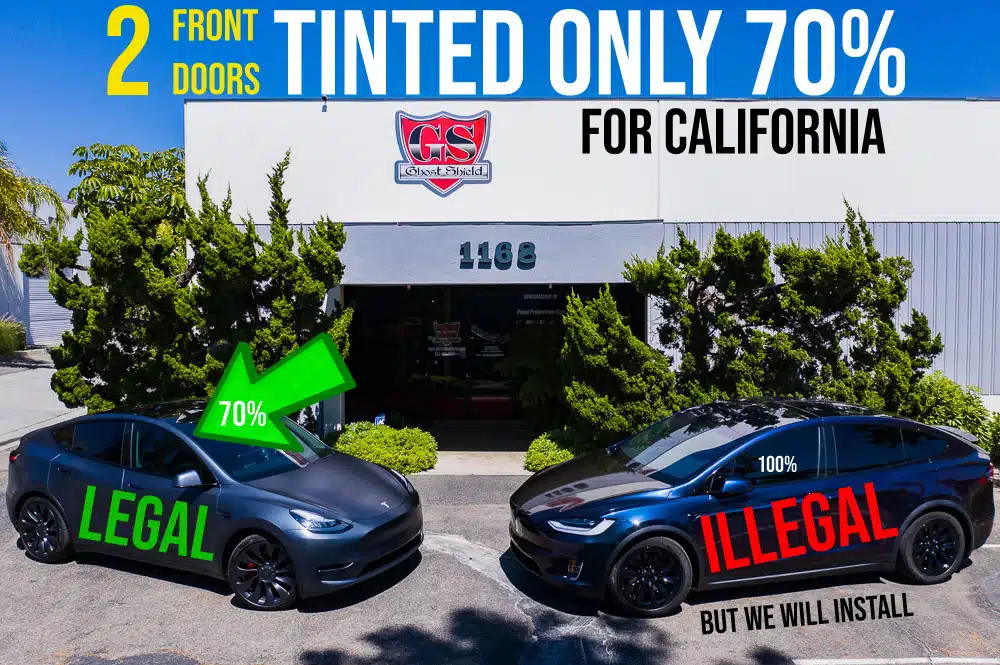
Everything you need to know about Tint Shades
Choosing the right window tint for your vehicle can be tricky, especially when balancing visibility, privacy, and legal regulations. So how dark is too dark when it comes to window tint on their vehicle? Let’s explore the options and brush up on legal limits as of 2024.
Window Tint Percentage Chart
So when it comes to tint…. how dark should you go? Let’s start at with Limo Tint. The darkest shade of them all… The infamous limo tint needs no introduction.
Limo tint is 5% tint.Meaning ONLY 5% of light passes through. Below is a representation of 5% tint at a molecular level.

Why Window Tint Darkness Matters
While the privacy of dark window tints is appealing, going too dark can be a safety hazard. Dark tints reduce your visibility, especially at night, which can increase the risk of accidents. Beyond your safety, law enforcement needs to see into your vehicle for security purposes. If your tint is too dark, you might face fines or even be asked to remove it.
The level of tint darkness is measured by VLT, or Visible Light Transmission. A higher VLT percentage means more light passes through the window, while a lower percentage means the window is darker. Knowing the VLT percentages and your state’s laws will help you stay safe and legal.
When deciding on what tint percentage to get, it’s essential to balance legal compliance, privacy, and visibility needs.
| Tint Level | VLT | Privacy | UV Protection | Heat Reduction | Best For |
|---|---|---|---|---|---|
| 5% (Limo Tint) | Very Dark – 5% VLT | Maximum | Excellent | Excellent | – VIP cars – Extreme privacy – Medical conditions like solar urticaria |
| 20% (Dark Tint) | Dark – 20% VLT | High | Excellent | Excellent | – SUVs – Trucks – Medical conditions like melanoma and lupus |
| 35% (Medium Tint) | Medium – 35% VLT | Moderate | Very Good | Very Good | – Sedans – Personal cars – Conditions like psoriasis and dermatomyositis |
| 50% (Light Tint) | Light – 50% VLT | Low | Good | Good | – Family vehicles – Medical needs such as actinic folliculitis |
| 70% (Very Light Tint) | Very Light – 70% VLT | Minimal | Some | Some | – New cars – Front windows – Medical conditions like pellagra |
| Ceramic Tint | Available in Various Levels | Depends on tint level | Superior | Superior | – Premium option for all vehicle types |
Choosing the Right Window Tint Percentage
When selecting a tint, it’s important to understand how different levels impact both appearance and functionality. Below, we explain the most common tint percentages and their effects on driving.
Balanced Comfort
A 50% tint allows half of the light to pass through, making it ideal for reducing glare and heat without significantly impacting nighttime visibility. This is a popular option for drivers who want a moderate tint that provides comfort and protection without compromising their ability to see clearly at night.
Stylish and Practical
For a sleek, stylish look, a 35% tint strikes a balance between privacy and visibility. It blocks more heat and UV rays than 50%, while still maintaining a safe level of visibility in most driving conditions.
Increased Privacy
A 20% tint provides enhanced privacy, making it difficult for outsiders to see into the vehicle. This darker option is preferred by those who prioritize privacy, though it may reduce visibility in low-light conditions.
Maximum Privacy (Limo Tint)
At 5% tint, this tint allows only 5% of light to pass through, offering maximum privacy. Commonly used in limousines and luxury vehicles, it provides excellent heat reduction but is often illegal on front windows due to safety concerns.
Benefits of Window Tinting
- Style: Transform your vehicle’s look with a sleek, modern finish that turns heads wherever you go.
- UV Protection: Block up to 99% of harmful UV rays to protect your skin and your vehicle’s interior from fading.
- Heat Reduction: Keep your car cooler by significantly reducing heat buildup, making your driving experience more comfortable.
- Privacy: Enhance your security with added privacy from prying eyes, allowing you to enjoy your space without worry.
How Dark Tint Affects Visibility

Dark tint levels, such as 20% and 5%, can greatly reduce your visibility at night. The key is to find a tint that balances privacy and style without compromising your ability to see clearly in low light. For drivers who frequently travel at night or in poorly lit areas, sticking to 35% or 50% tint is often the safer option.
California Tint Laws

These laws help ensure that drivers maintain adequate visibility, especially at night. In many cases, laws differ for the front and rear windows, with the front requiring higher light transmission for safety. In California, for instance, the law requires that the front side windows must allow more than 70% of light to pass through, while there are no restrictions on how dark you can go with your rear windows.
| Window Location | Tint Law |
|---|---|
| Front Side Windows | 70% VLT or more |
| Rear Side Windows | No restrictions |
| Rear Windshield | No restrictions |
| Windshield Strip | Upper 4-6 inches only |
Window Tint Laws by State
Tint laws vary from state to state, and it’s essential to know your local regulations before applying any tint to your vehicle’s side windows and front windshield. Below are general guidelines for legal window tint percentages across different states, including specific regulations for side windows, rear windows, and windshields.
| State | Front Side Windows | Rear Side Windows | Rear Windshield | Windshield Strip |
|---|---|---|---|---|
| Arizona | 33% VLT | 33% VLT | 33% VLT | Upper 4 inches |
| Texas | 25% VLT | 25% VLT | 25% VLT | Upper 5 inches or AS-1 line |
| Florida | 28% VLT | 15% VLT | 15% VLT | Upper AS-1 line |
| New York | 70% VLT | 70% VLT | 70% VLT | Upper 6 inches |
| Michigan | No tint allowed | Any | Any | Upper 4 inches |
| Nevada | 35% VLT | 20% VLT | 20% VLT | Upper AS-1 line |
| Georgia | 32% VLT | 32% VLT | 32% VLT | Upper 6 inches |
| Ohio | 50% VLT | 50% VLT | 50% VLT | Upper 5 inches |
Medical Exemptions for Window Tint
In some cases, individuals may qualify for medical exemptions to apply darker window tints than typically allowed by law. Conditions such as photophobia or lupus—both of which require protection from UV rays—can make you eligible for an exemption.
Medical Conditions That May Qualify for Exemptions:
- Photophobia (light sensitivity)
- Lupus (requiring extra UV protection)
- Skin Cancer
- Melanoma
- Vitiligo
According to a review published in the National Institutes of Health’s PMC, UV radiation has been linked to various skin disorders, including skin cancer, as well as acute and chronic effects on skin health. When selecting the appropriate tint level, it’s important to balance comfort, privacy, and legal requirements. If you suffer from a medical condition that requires extra protection from sunlight, always consult local laws and consider discussing your needs with a healthcare professional to ensure you choose the best option for your health and vehicle.
Choosing the Right Tint for Your Vehicle
Choosing the right window tint involves balancing comfort, privacy, visibility, and legal requirements. By understanding the various tint levels and state regulations, you can make an informed decision that enhances both your driving experience and your vehicle’s aesthetic. Whether you’re opting for the subtle protection of a 50% tint or the privacy of a 20% tint, Ghost Shield Film has the perfect solution to fit your needs.
Our films block harmful UV rays, reduce glare, and protect your car’s interior from heat damage, all while giving you the privacy and style you desire. If you’re unsure about which tint level is right for you, our team is here to help guide you through the selection process.
Tint Options Available
- STANDARD TINT: Affordable and Long Lasting. Ideal for basic protection and aesthetic enhancement.
- CERAMIC TINT: Offers superior heat rejection, UV protection, and glare reduction while maintaining a clear view. Recommended by Skin Cancer Foundation
- WINDSHIELD TINT or ROOF GLASS: Popular Add-On. Windshield tint can help reduce glare from the sun, headlights, and other bright lights on the road.
Learn more about the differences between Standard, Ceramic, and Metallic tint in our other blog post. What tint is best
Check Out Our TINT PACKAGES!
Ready to get your windows tinted while staying within legal limits? Contact Ghost Shield today to explore our tint options and ensure your vehicle looks sharp and stays compliant. Plus, enjoy a lifetime warranty on tint to give you peace of mind with your investment!
